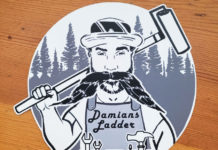It was summer, 1891. The new town of Ben Lomond rose up several levels—physically and socially. The low ground along the river belonged to commerce. Enterprises of all sorts—store and post office, several salons and, allegedly, houses of prostitution lined the street across from the Pacific Mill. Although Pierce and other promoters hoped to call the road “Ben Lomond Avenue, the name “Mill Street” stuck.
Uphill, across the railroad tracks, a sub-division of summer cottages took shape. Prospective residents were lured with the promise of “a perfect system of water works,” and were reminded that the continued presence of the saw mill would provide cheap and accessible building material.
Somewhat higher still was the Hotel Ben Lomond, overlooking the river at the north end of town. Pierce had offered to give the site to “any proper and competent party” willing to finish the project, but eventually financed it himself. His assistant, Thomas Bell, architect of the saw mill, supervised the construction. According to W. S. Rogers, the local supervisor at the time, the timber baron was a demanding employer. “We encountered a barley sack lying on the ground, “he recalled. “Mr. Pierce picked it up on the end of his cane and mildly reproved Mr. Bell for permitting such a state of things to exist.”
When the new summer resort opened in June, 1889, the San Francisco and Oakland papers touted the convenient railroad station, the local trees and, especially, “good fishing, etc.” The two-story main building was a work in progress. Another twelve rooms were added after the first year and also a children’s dining room. The feature of 1890 was an elegant clubhouse, complete with dance floor, billiard tables, “a lavatory, baths, etc.”
The flood of January 1890 rushed harmlessly past the hotel grounds. As the San Lorenzo began to overflow, employees of the store moved its goods across the street to the mill, then they watched as the river knocked a few buildings off their foundations.
Hotel Ben Lomond proved popular with society people from the cities that summer. The rooms and cottages were fully occupied, but the profits proved elusive when the landlady left suddenly with the proceeds at the end of the season.
Pierce continued to sponsor community amenities. An estimated 3,000 trees were distributed throughout the village —“elm, walnut, ash, locust, red gum and others.” The Land and Lumber Company also constructed a small church and offered it as a free gift to any denomination that promised to initiate regular preaching. The Presbyterians spoke first and claimed the prize.
New management was recruited from Santa Cruz and, in the spring of 1891, the resort prepared to accommodate over 100 guests. Water sports — fishing and swimming — were heavily advertised. The Surf liked the combination of cool mountain air and “the pleasure of the piscatorial art.” The Sentinel spoke of “speckled beauties biting at everything bite-able.” Bathhouses, including swimming tanks were erected along Love Creek and the San Lorenzo.
Members of Pierce’s large extended family — seven children, including two teenage girls — were frequent guests at his home and the hotel. It is likely that, in addition to business matters, Mr. Pierce discussed his personal plans with his sons and daughters. His wife had passed away several years earlier and the entrepreneur, now in his mid-sixties, intended to marry again. His choice — a widow half his age, who had once worked in his household — did not please his prospective heirs. To keep the peace, Pierce’s lawyers arranged to distribute his corporate holdings before the wedding.
In August, a letter from hotel guest Winifred Bowen, Pierce’s 7-year old great-niece, to her sister in England somehow made it into the columns of the Surf. After mentioning the garden and croquet court, she observed that: “There is a nice creek and one day we went down there. There is a pond which I have seen and the men go in swimming. There is a mill pond, which logs used to be pushed into, then taken out and sawed.”
Her use of the past tense was correct. The profits from the lumber business had steadily declined, due to competition from mills in Boulder Creek and Santa Cruz, resulting in over-production and price wars. For some time, Pierce had quietly sold off his timber lands and, during the summer of 1891, shut down the Pacific Mill.
To Be Continued.
Randall C. Brown is a local historian and is a member of the SLVWD Board of Directors













